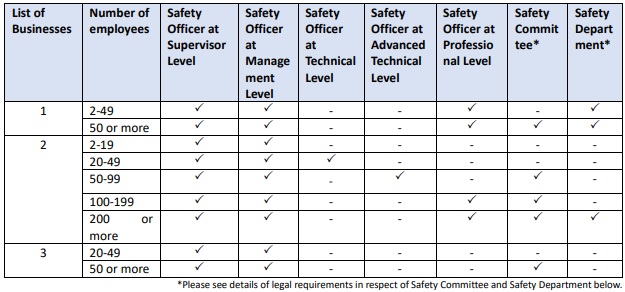Background
The Occupational Safety, Health, and Environmental Act of 2011 (the "OSHA") is the main legislation governing the protection of labour in relation to occupational health and safety matters in work places. The OSHA stipulates the obligation on employers to provide safety officers, a safety committee, and a safety department to carry out safety matters in their work places in accordance with the relevant criteria, methods, and conditions, under the supervision of the Department of Labour Protection and Welfare (the "DLPW"), the Ministry of Labour.
On 17 June 2022, the Ministerial Regulation on Arrangement of Occupational Safety Officers, Personnel, Department, or Committee to Operate Safety in the Workplace of 2022, dated 2 June 2022 (the "New Regulation") was published in the Royal Thai Government Gazette. The New Regulation, which becomes effective on 16 August 2022, is issued under the OSHA to entirely revoke the Ministerial Regulation on the Prescribing of Standards for Administration and Management of Occupational Safety, Health, and Environment, of 2006 dated 16 May 2006 (the "Former Regulation"), which was issued by virtue of the Labour Protection Act of 1998 since 2006.
Key Takeaway
In principle, the New Regulation overhauls the old criteria, qualifications, and requirements for appointment of safety officers, a safety committee, and a safety department in the workplace for several businesses. A summary of the major provisions is as follows:
1. Revised Target Businesses
The New Regulation is applicable to a wide range of businesses in the 64 businesses set forth in the annex to the New Regulation (please see the list at the bottom of this article). It categorizes the target businesses into List 1, List 2, and List 3, which correspond to the level of safety risk in the workplace: i.e., high, medium, and low, respectively. It would appear, from our review, that all of the businesses which are presently subject to the Former Regulation are also covered under the New Regulation; however, some – such as hotels, department stores, and hospitals – are subject to more stringent requirements than those under the Former Regulation. Moreover, the New Regulation is more specific in relation to the businesses subject to it, including in relation to businesses whose operators had, prior to its issuance, been unsure whether the Former Regulation applied to them. Those businesses include but are not limited to zoos; amusement parks; convention halls; cooperatives; securities businesses; insurance businesses; pawnshops; movie studios; sports stadiums; and restaurants or bars with live music or shows for entertainment.
2. Appointment of Safety Officers
In principle, the target businesses are required to appoint safety officers to supervise and manage the occupational safety, health, and environment in the workplace. The requirements in respect of the level of safety officer vary depending on (i) the categorization of the businesses pursuant to the relevant List under the New Regulation and (ii) the number of employees in the workplace. All are summarized per the table below.

Upon consideration of the New Regulation, we understand that many businesses who have duly registered safety officers for their business can continue operation without the need for any new appointment of safety officers. However, we recommend that certain businesses, especially those in the service sector, verify the New Regulation and ensure compliance therewith, since the requirements relating to safety officers with respect to some of them have changed. For instance, the Former Regulation required hotels, department stores, and hospitals which have 20 employees or more to appoint only a safety officer at supervisor level and a safety officer at management level. However, the New Regulation categorizes them as businesses in List 2 and therefore required to additionally appoint a safety officer at technical level or higher level, depending on the number of employees.
3. Qualifications and Duties of Safety Officers
Under the New Regulation, the qualifications and duties of safety officers are rather similar to those under the Former Regulation. However, there are some changes, highlighted as follows:
3.1 Qualifications of Safety Officer at Technical Level
The safety officer at technical level is no longer limited to persons who hold a bachelor's degree in occupational health or have been working as a safety officer at supervisor level. The New Regulation allows a business to select its employees holding any educational degree to attend the training and register as the safety officer at technical level of the workplace.
3.2 Qualifications of Safety Officer at Professional Level
Likewise, the safety officer at professional level is no longer limited to persons who hold a bachelor's degree in occupational health or have been working as the safety officer at advanced technical level for over 5 years. The New Regulation allows any person who has graduated with at least a bachelor's degree, in any field, and who possesses work experience of more than 5 years in the business under List 1 or List 2 and passes the training within 5 years from the enforcement of the New Regulation, to register as the safety officer at professional level. The DLPW is in the process of drafting the details of such training program, and the details are expected to be issued in the very near future.
3.3 Duties of Safety Officer at Supervisor Level
Any person who is appointed as the safety officer at supervisor level has the additional duty of preparing a manual concerning the occupational safety, health, and environment for the business unit of which he/she is in charge. This manual must be reviewed every 6 months.
3.4 Duties of Safety Officer at Technical Level
Under the Former Regulation, the safety officer at technical level may be stationed at the workplace for only 1 hour per day. However, under the New Regulation, the safety officer at technical level must be stationed full-time at the workplace.
3.5 Training Duties of Safety Officer
Under the New Regulation, the respective safety officers at technical level, advanced technical level, and professional level must attend a training or program, for at least 12 hours per year, to develop their knowledge on safety in the workplace, and the business must report to the relevant official within 30 days after the completion of such training or program. The DLPW is in the process of drafting the details of such training or program, and the details are expected to be issued in the very near future.
4. Requirement for Safety Committee
The legal requirements under the Former Regulation with respect to a business with 50 employees or more to establish the Committee on Occupational Safety, Health and Environment of the Workplace (the "Safety Committee") remain the same under the New Regulation, with the exception of the minor change, under the New Regulation, that the employees can freely choose their representatives on the Safety Committee by any method –i.e., there is no longer the limitation of "election".
5. Requirement for Safety Department
Under the New Regulation, businesses in List 2 who have 200 or more employees, and businesses in List 1, must establish a safety department of the workplace, in the same way required under the Former Regulation. From our reviewing, the New Regulation should not affect those businesses that have already set up a safety department under the Former Regulation. However, businesses which under the Former Regulation had no safety department but whose business falls under List 1 or List 2 under the New Regulation needs to prepare for the establishment of the safety department if the number of their employees reaches the minimum requirement.
This New Regulation also clarifies that an executive (head) of the safety department cannot hold the position of safety officer at professional level for the workplace simultaneously. As a result, if the safety officer at professional level is promoted to be the executive (head) of the safety department, the business must appoint a new safety officer at professional level for the vacant position.
6. Duty to Report
In general, the existing responsibilities of the business to register the appointment of safety officers and submit the safety officers' operational performance reports periodically remain unchanged. However, the New Regulation introduces new reporting duties on the part of the business, as follows:
6.1 For businesses required to establish the safety department under the New Regulation, the name of the executive (head) of the safety department must be registered with the DLPW within 30 days from the date of appointment.
6.2 If safety officers or executives (head) of the safety department are to resign or be removed from their position, either the business or a safety officer or executive (head) of the safety department must notify the DLPW within 30 days from the date of resignation or removal.
6.3 The safety officer at technical level must prepare and submit the 'operational performance report of the safety officer' to the relevant official.
6.4 The period in respect of submission of the operational performance report of the safety officer is reduced from every 3 months under the Former Regulation to every 6 months under the New Regulation, i.e. by 30 June and 31 December of each year.
Conclusion
The New Regulation is expected to enhance safety in the workplace. During the transitional period, all the existing safety officers, executives (head) of the safety department, and the member in the Safety Committee, appointed or established under the Former Regulation remains valid while the New Regulation remains in effect. However, for any business which has already provided training to employees in order to comply with the Former Regulation but has not yet registered (if legally required) with the DLPW, please note that it is likely that the training program already conducted may not be acceptable under the New Regulation. Furthermore, as the New Regulation is applicable to a wide range of businesses, many businesses, especially those in the service sector, must study and implement the New Regulation since they may be subject to more stringent legal requirements.
Lists of types of businesses, annexed to the New Regulation
List 1
- Industry on Mining under Minerals Law
- Industry on Petroleum Business under Petroleum Law
- Industry on Petrochemicals
- Industry on Petroleum Refineries
- Industry on Natural Gas Separation
List 2
- Industry on Printing
- Industry on Food Products
- Industry on Beverages
- Industry on Tobacco Products
- Industry on Textiles
- Industry on Garments
- Industry on Leathers
- Industry on Wood Products
- Industry on Paper or Paper Processed Products
- Industry on Chemicals or Chemical Product Production
- Industry on Pharmaceutical Products or Medical Supplies
- Industry on Rubber Products
- Industry on Plastic Products
- Industry on Non-Metallic Mineral Products
- Industry on Metals or Metal Products
- Industry on Electronic Devices
- Industry on Electrical Appliances or Electrical Devices
- Industry on Machinery or Machine Tools
- Industry on Vehicles, Vehicle Parts, or Vehicle Accessories
- Industry on Furniture
- Industry on Jewelry
- Industry on Musical Instruments
- Industry on Sports and Fitness equipment
- Industry on Toys
- Industry on Medical Equipment and Tools
- Industry on Electricity Power Generation, Transmission, or Distribution
- Industry on Gas Production or Filling
- Industry on Coke Production
- Industry on Steam Production, Storage, or Distribution
- Industry on Livestock or Cultivation
- Service Stations under Fuel Trade Law
- Fuel Depots under Fuel Control Law
- Wastewater Treatment or Waste Disposal Services under Enhancement and Conservation of National Environmental Quality Law
- Industry on Recycling and Reuses
- Industry on Mineral Dressing, Mineral Mining on a Minor Scale or Mineral Panning under Minerals Law
- Construction, Modification, Repairing or Demolition under Building Control Law
- Industry on Transport
- Air Navigation Services under Air Navigation Law
- Warehouse Businesses, Silo Businesses or Cold Storage Businesses under Warehouse, Silo, and Cold Storage Law
- Telecommunication Businesses under Law on Organization to Assign Radio Frequency and to Regulate the Broadcasting and Telecommunications Business Operation
- Machinery Installations, Repairing, or Maintenances
- Hotels under Hotel Law
- Condominium Juristic Person Businesses under Condominium Law
- Department Stores, Retail Businesses or Wholesale Businesses
- Trade Exhibitions and Convention Centres
- Hospitals
- Testing and Analysis on Physical, Chemical, Biological or Engineering Operations
- Automobile Distribution and Maintenance or Repair
- Zoos or Amusement Parks
List 3
- Financial Institutions under Financial Institutions Law
- Securities Business under Securities and Exchange Law
- Cooperatives under Cooperatives Law
- Life Insurance Business under Life Insurance Law or Non-Life Insurance Business under Non-Life Insurance Law
- Pawnshops under Pawnshop Law
- Movie or Drama Studios
- Botanical Gardens
- Sports Stadiums or Recreation Places
- Places Selling Food, Alcohol, or Other Beverages with Live Music or any Show for Entertainment.
- Management Offices of Businesses in List 1 and List 2
Originally Published August 2022
The content of this article is intended to provide a general guide to the subject matter. Specialist advice should be sought about your specific circumstances.


